Pic Story: Inheritor of Chu-style Lacquer Coating Craft

Lacquer coated tea sets are displayed at Hao Guanxiong's studio in Changsha, central China's Hunan Province, Feb. 28. 2024. Chu-style lacquer coating craft took shape during the Spring and Autumn Period (770 B.C.-476 B.C.) and the Warring States Period (475 B.C.-221 B.C.). Over the past thousands of years, this oriental craft has been mainly used on wood carving artworks and famous for its complicated making, distinguished styles, varied patterns and saturated colors. In 2011, the craft was listed as one of the national-level intangible cultural heritage.
Hao Guanxiong, born in central China's Hubei Province in 1992, is an inheritor of the craft. Fascinated with handmade work and painting since childhood, he was accepted by Chinese master of arts and crafts Liu Bijian as apprentice. Having worked on the craft for over ten years, he finally set up his own brand "Xiaojiaoqi" in Changsha of Hunan Province, aiming to create more artworks and promote the craft.
"I do not only want to see the artworks displayed in the museums, but also in our daily life by integrating modern designs with traditional ones," said Hao, "I hope that more people will use lacquer artworks and the craft will be better preserved." (Xinhua/Chen Sihan)
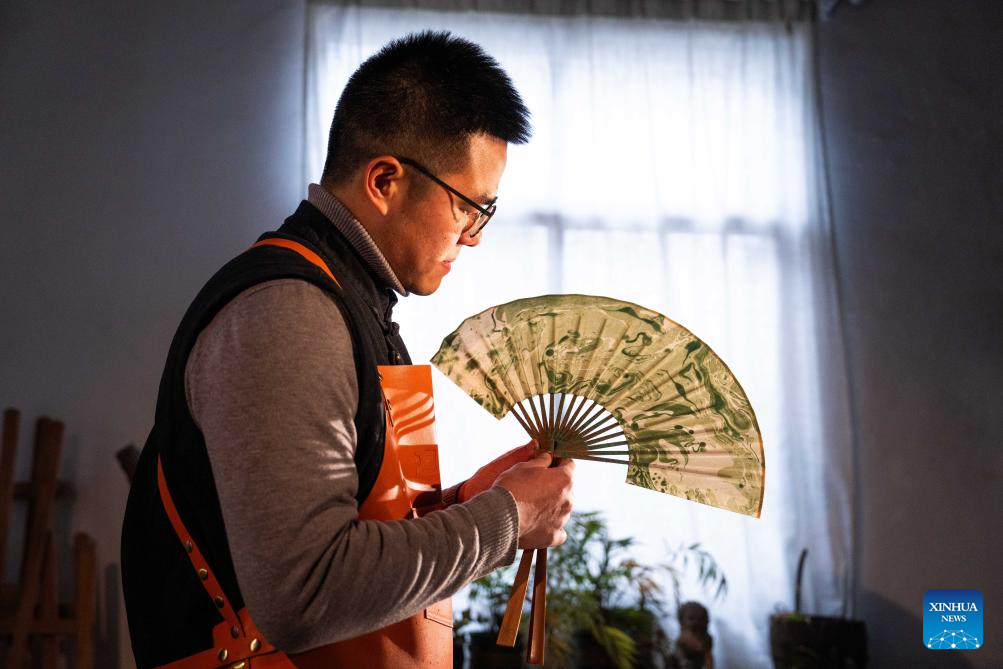
Hao Guanxiong checks a lacquer coated fan at his studio in Changsha, central China's Hunan Province, Feb. 28. 2024. Chu-style lacquer coating craft took shape during the Spring and Autumn Period (770 B.C.-476 B.C.) and the Warring States Period (475 B.C.-221 B.C.). Over the past thousands of years, this oriental craft has been mainly used on wood carving artworks and famous for its complicated making, distinguished styles, varied patterns and saturated colors. In 2011, the craft was listed as one of the national-level intangible cultural heritage.(Xinhua/Chen Sihan)
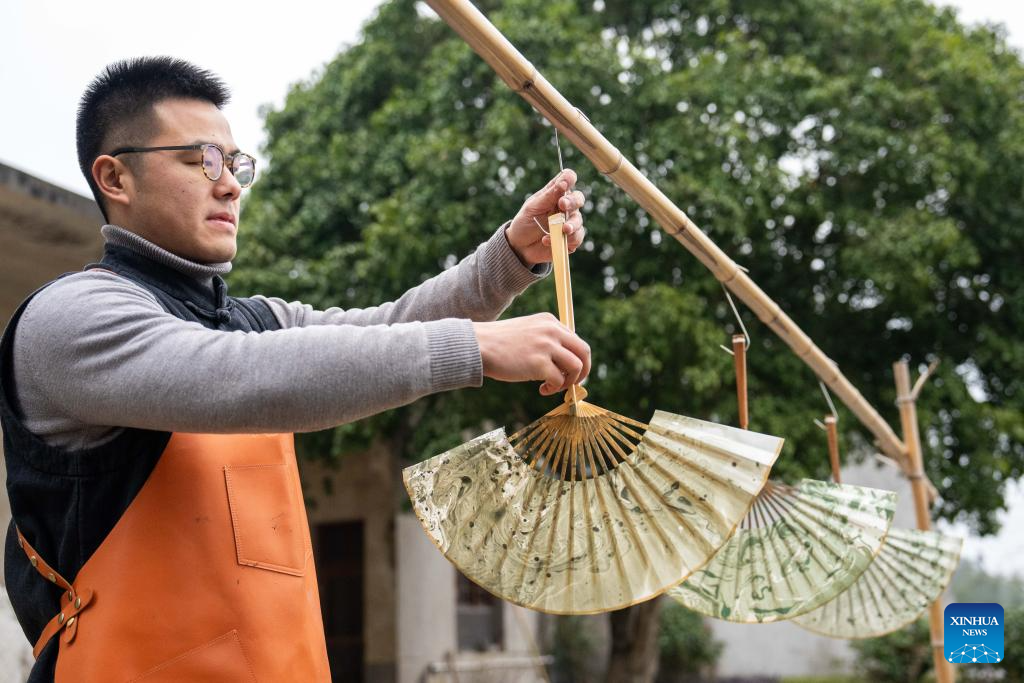
Hao Guanxiong dries lacquer coated fans at his studio in Changsha, central China's Hunan Province, Feb. 28. 2024. Chu-style lacquer coating craft took shape during the Spring and Autumn Period (770 B.C.-476 B.C.) and the Warring States Period (475 B.C.-221 B.C.). Over the past thousands of years, this oriental craft has been mainly used on wood carving artworks and famous for its complicated making, distinguished styles, varied patterns and saturated colors. In 2011, the craft was listed as one of the national-level intangible cultural heritage.(Xinhua/Chen Sihan)
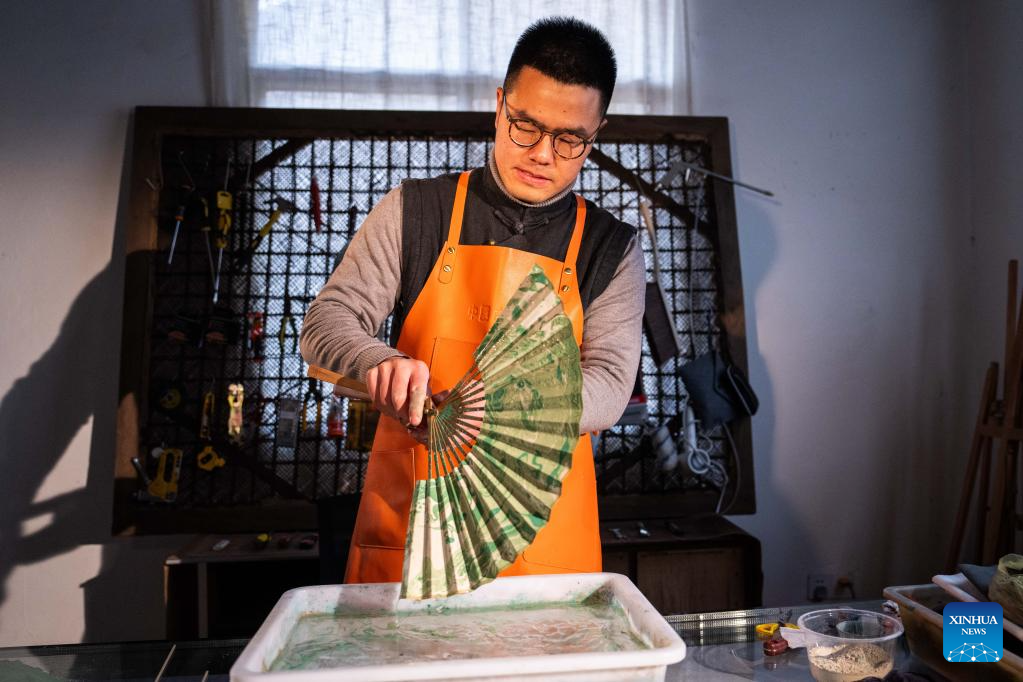
Hao Guanxiong makes lacquer coated fan at his studio in Changsha, central China's Hunan Province, Feb. 28. 2024. Chu-style lacquer coating craft took shape during the Spring and Autumn Period (770 B.C.-476 B.C.) and the Warring States Period (475 B.C.-221 B.C.). Over the past thousands of years, this oriental craft has been mainly used on wood carving artworks and famous for its complicated making, distinguished styles, varied patterns and saturated colors. In 2011, the craft was listed as one of the national-level intangible cultural heritage. (Xinhua/Chen Sihan)

Hao Guanxiong prepares for making lacquer coated fan at his studio in Changsha, central China's Hunan Province, Feb. 28. 2024. Chu-style lacquer coating craft took shape during the Spring and Autumn Period (770 B.C.-476 B.C.) and the Warring States Period (475 B.C.-221 B.C.). Over the past thousands of years, this oriental craft has been mainly used on wood carving artworks and famous for its complicated making, distinguished styles, varied patterns and saturated colors. In 2011, the craft was listed as one of the national-level intangible cultural heritage.(Xinhua/Chen Sihan)
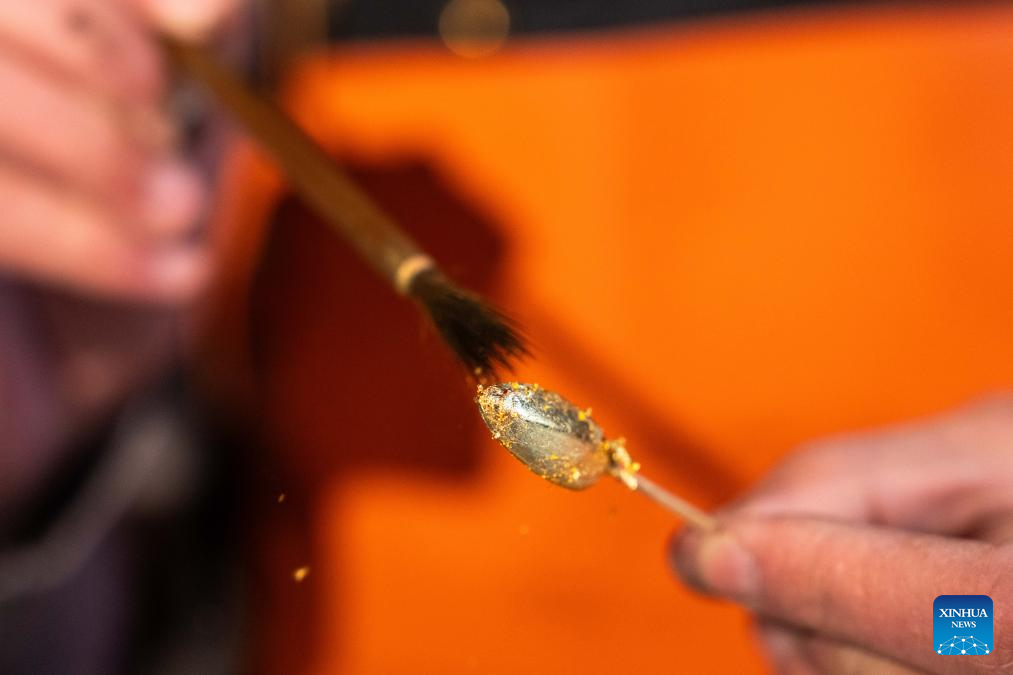
Hao Guanxiong puts a gold leaf on an artwork at his studio in Changsha, central China's Hunan Province, Feb. 28. 2024. Chu-style lacquer coating craft took shape during the Spring and Autumn Period (770 B.C.-476 B.C.) and the Warring States Period (475 B.C.-221 B.C.). Over the past thousands of years, this oriental craft has been mainly used on wood carving artworks and famous for its complicated making, distinguished styles, varied patterns and saturated colors. In 2011, the craft was listed as one of the national-level intangible cultural heritage. (Xinhua/Chen Sihan)
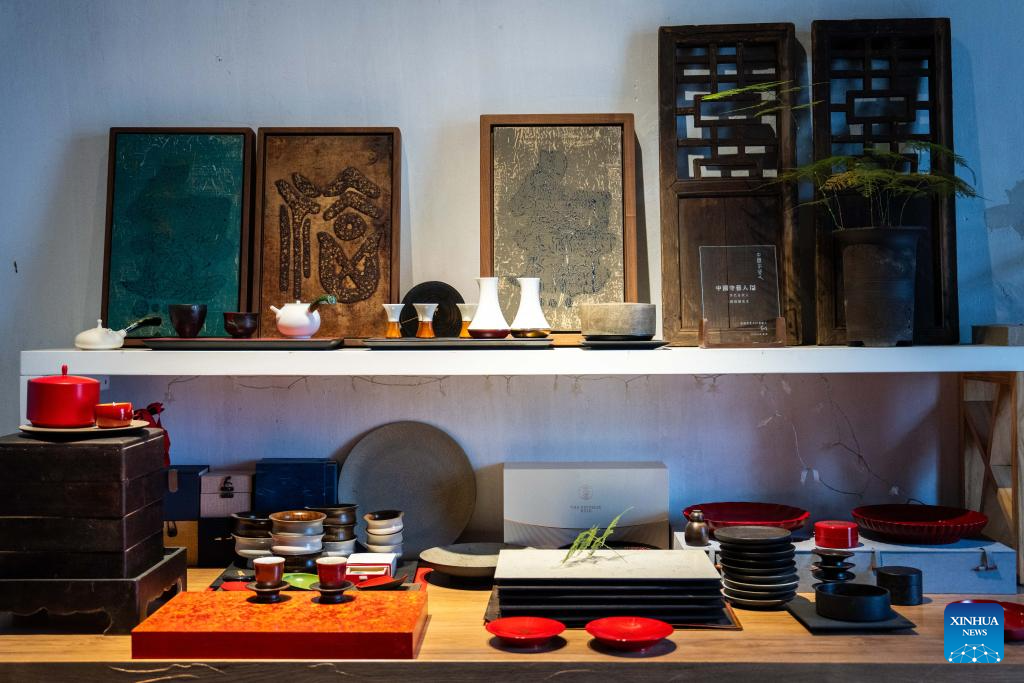
Lacquer coated artworks are displayed at Hao Guanxiong's studio in Changsha, central China's Hunan Province, Feb. 28. 2024. Chu-style lacquer coating craft took shape during the Spring and Autumn Period (770 B.C.-476 B.C.) and the Warring States Period (475 B.C.-221 B.C.). Over the past thousands of years, this oriental craft has been mainly used on wood carving artworks and famous for its complicated making, distinguished styles, varied patterns and saturated colors. In 2011, the craft was listed as one of the national-level intangible cultural heritage.(Xinhua/Chen Sihan)

Hao Guanxiong prepares for making lacquer coated fan at his studio in Changsha, central China's Hunan Province, Feb. 28. 2024. Chu-style lacquer coating craft took shape during the Spring and Autumn Period (770 B.C.-476 B.C.) and the Warring States Period (475 B.C.-221 B.C.). Over the past thousands of years, this oriental craft has been mainly used on wood carving artworks and famous for its complicated making, distinguished styles, varied patterns and saturated colors. In 2011, the craft was listed as one of the national-level intangible cultural heritage.(Xinhua/Chen Sihan)
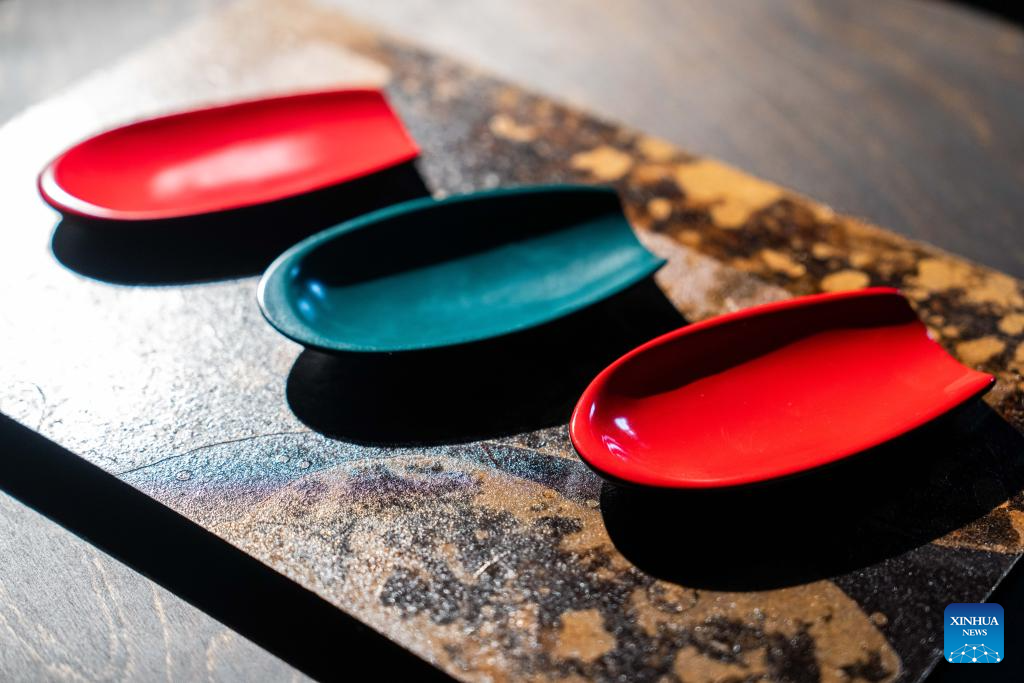
Lacquer coated tea sets are displayed at Hao Guanxiong's studio in Changsha, central China's Hunan Province, Feb. 28. 2024. Chu-style lacquer coating craft took shape during the Spring and Autumn Period (770 B.C.-476 B.C.) and the Warring States Period (475 B.C.-221 B.C.). Over the past thousands of years, this oriental craft has been mainly used on wood carving artworks and famous for its complicated making, distinguished styles, varied patterns and saturated colors. In 2011, the craft was listed as one of the national-level intangible cultural heritage. (Xinhua/Chen Sihan)
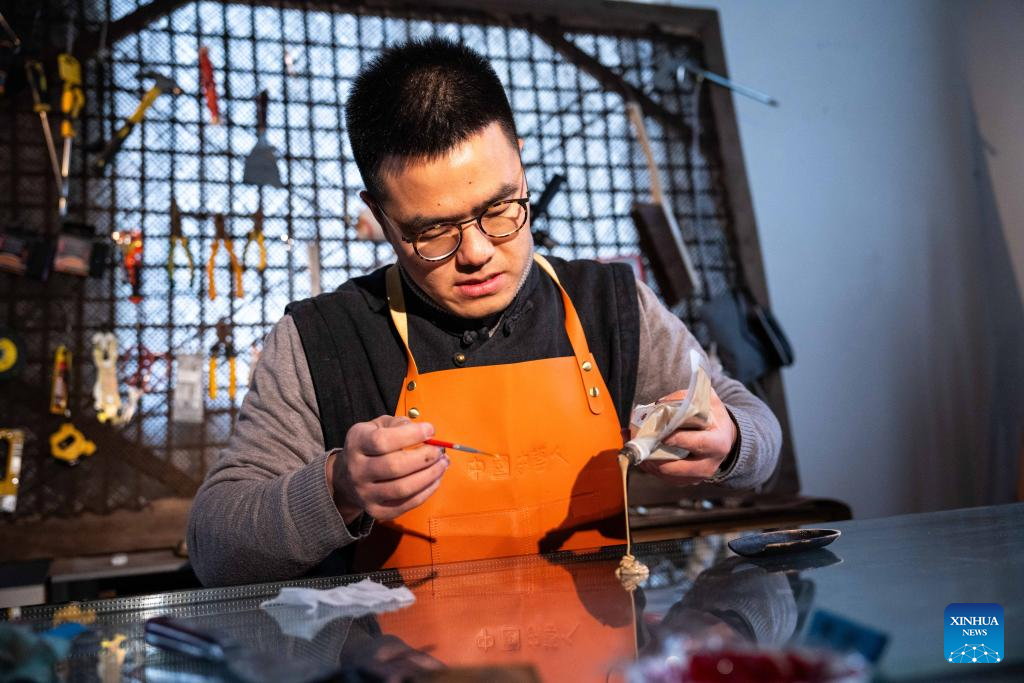
Hao Guanxiong makes lacquer at his studio in Changsha, central China's Hunan Province, Feb. 28. 2024. Chu-style lacquer coating craft took shape during the Spring and Autumn Period (770 B.C.-476 B.C.) and the Warring States Period (475 B.C.-221 B.C.). Over the past thousands of years, this oriental craft has been mainly used on wood carving artworks and famous for its complicated making, distinguished styles, varied patterns and saturated colors. In 2011, the craft was listed as one of the national-level intangible cultural heritage.(Xinhua/Chen Sihan)
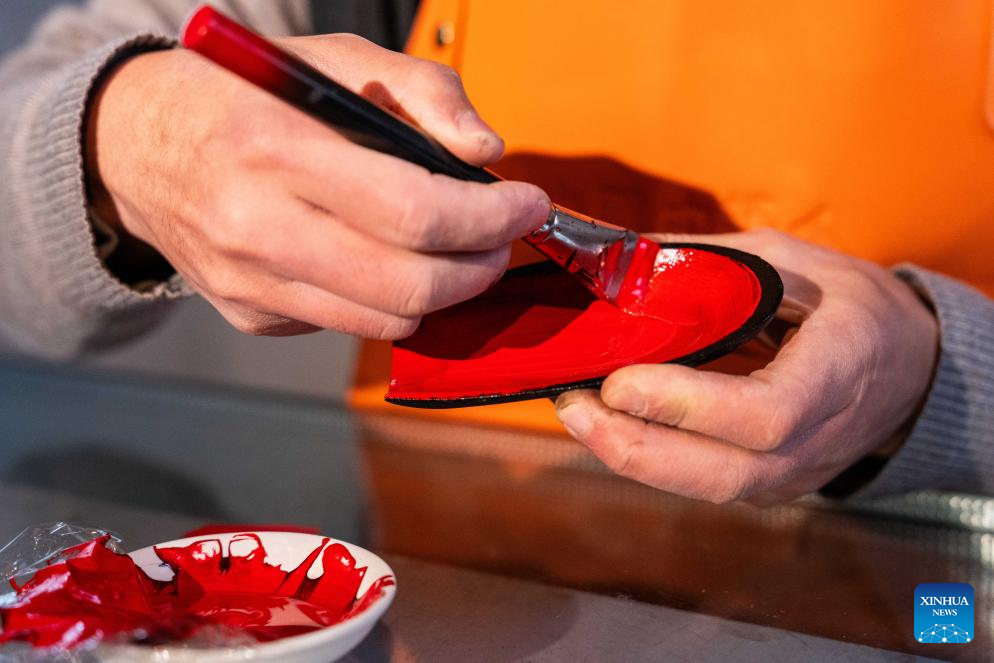
Hao Guanxiong paints lacquer on a semi-finished artwork at his studio in Changsha, central China's Hunan Province, Feb. 28. 2024. Chu-style lacquer coating craft took shape during the Spring and Autumn Period (770 B.C.-476 B.C.) and the Warring States Period (475 B.C.-221 B.C.). Over the past thousands of years, this oriental craft has been mainly used on wood carving artworks and famous for its complicated making, distinguished styles, varied patterns and saturated colors. In 2011, the craft was listed as one of the national-level intangible cultural heritage. (Xinhua/Chen Sihan)
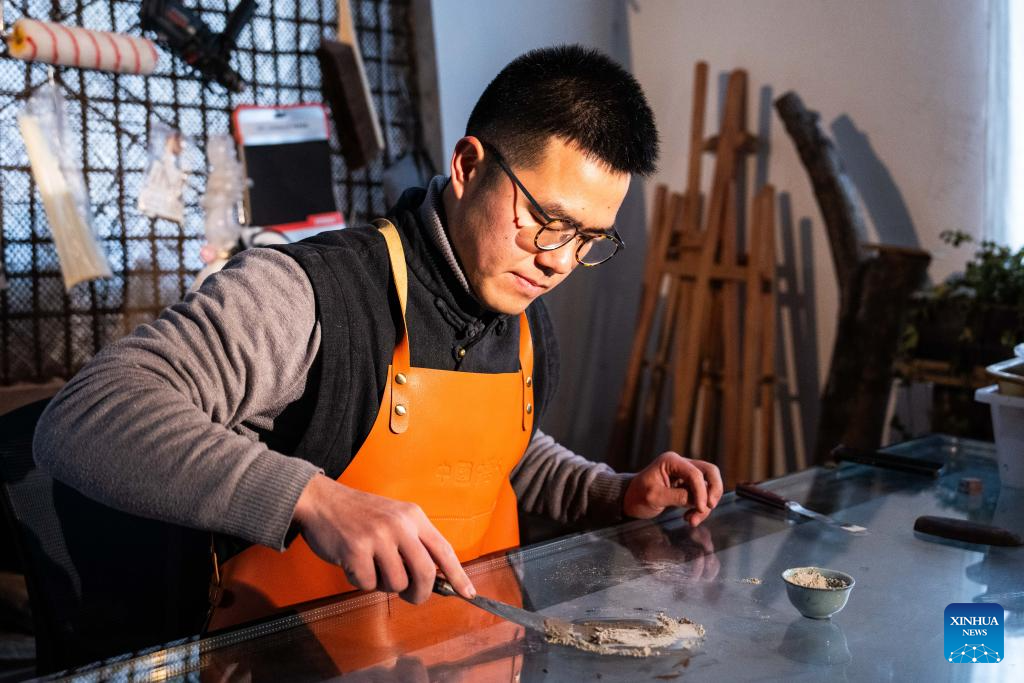
Hao Guanxiong makes lacquer at his studio in Changsha, central China's Hunan Province, Feb. 28. 2024. Chu-style lacquer coating craft took shape during the Spring and Autumn Period (770 B.C.-476 B.C.) and the Warring States Period (475 B.C.-221 B.C.). Over the past thousands of years, this oriental craft has been mainly used on wood carving artworks and famous for its complicated making, distinguished styles, varied patterns and saturated colors. In 2011, the craft was listed as one of the national-level intangible cultural heritage. (Xinhua/Chen Sihan)
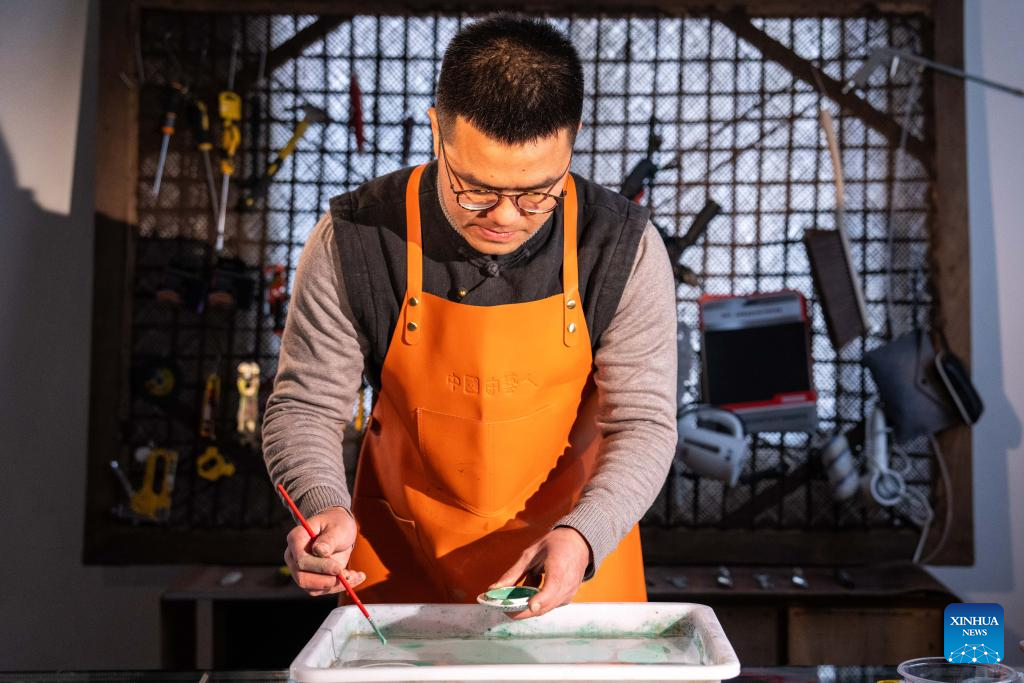
Hao Guanxiong prepares for making lacquer coated fan at his studio in Changsha, central China's Hunan Province, Feb. 28. 2024. Chu-style lacquer coating craft took shape during the Spring and Autumn Period (770 B.C.-476 B.C.) and the Warring States Period (475 B.C.-221 B.C.). Over the past thousands of years, this oriental craft has been mainly used on wood carving artworks and famous for its complicated making, distinguished styles, varied patterns and saturated colors. In 2011, the craft was listed as one of the national-level intangible cultural heritage.(Xinhua/Chen Sihan)
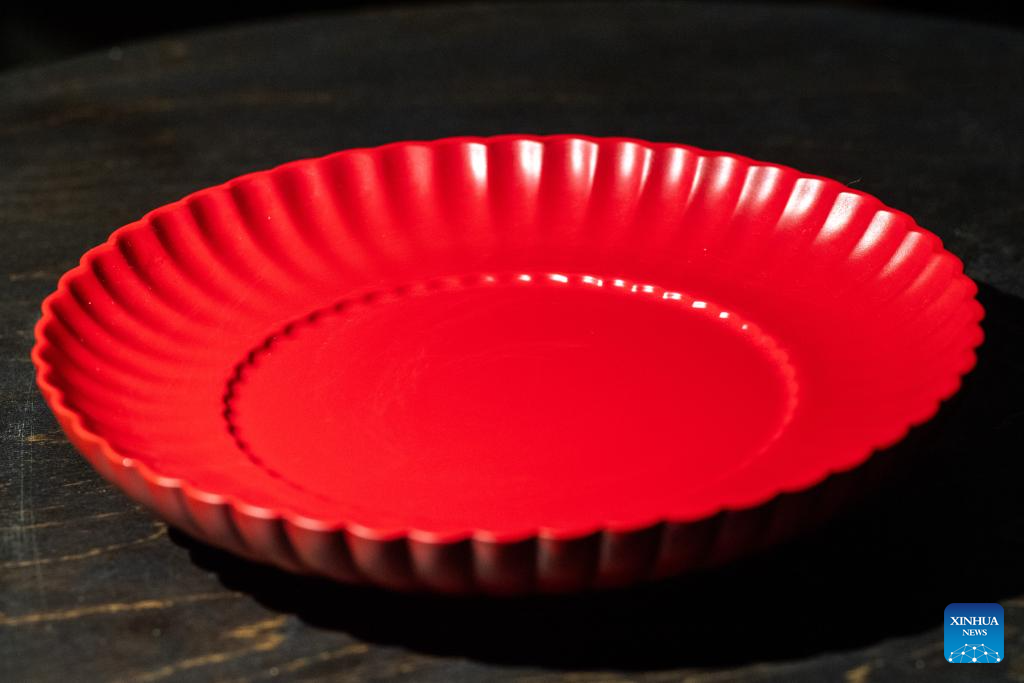
A lacquer coated plate is displayed at Hao Guanxiong's studio in Changsha, central China's Hunan Province, Feb. 28. 2024. Chu-style lacquer coating craft took shape during the Spring and Autumn Period (770 B.C.-476 B.C.) and the Warring States Period (475 B.C.-221 B.C.). Over the past thousands of years, this oriental craft has been mainly used on wood carving artworks and famous for its complicated making, distinguished styles, varied patterns and saturated colors. In 2011, the craft was listed as one of the national-level intangible cultural heritage.(Xinhua/Chen Sihan)
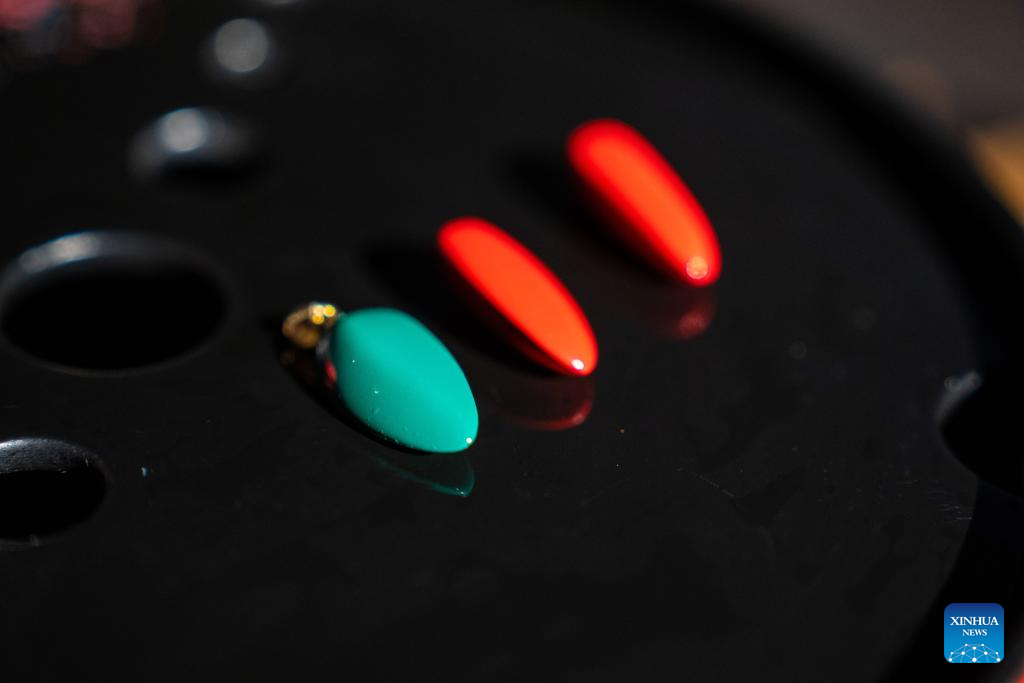
Melon-seed-shaped lacquer coated pendants are displayed at Hao Guanxiong's studio in Changsha, central China's Hunan Province, Feb. 28. 2024. Chu-style lacquer coating craft took shape during the Spring and Autumn Period (770 B.C.-476 B.C.) and the Warring States Period (475 B.C.-221 B.C.). Over the past thousands of years, this oriental craft has been mainly used on wood carving artworks and famous for its complicated making, distinguished styles, varied patterns and saturated colors. In 2011, the craft was listed as one of the national-level intangible cultural heritage. (Xinhua/Chen Sihan)
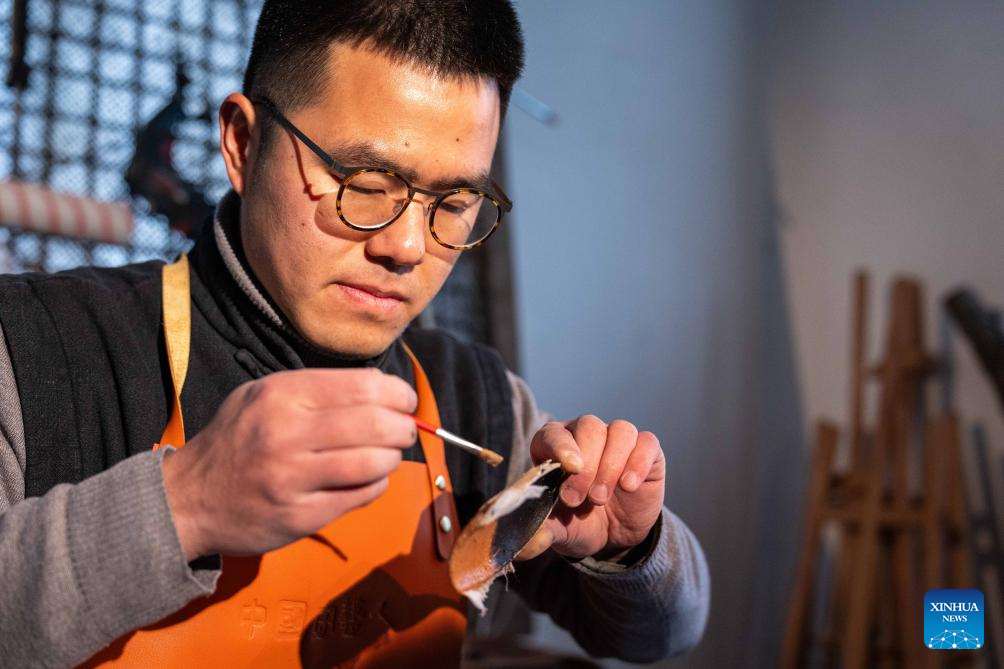
Hao Guanxiong makes an artwork at his studio in Changsha, central China's Hunan Province, Feb. 28. 2024. Chu-style lacquer coating craft took shape during the Spring and Autumn Period (770 B.C.-476 B.C.) and the Warring States Period (475 B.C.-221 B.C.). Over the past thousands of years, this oriental craft has been mainly used on wood carving artworks and famous for its complicated making, distinguished styles, varied patterns and saturated colors. In 2011, the craft was listed as one of the national-level intangible cultural heritage. (Xinhua/Chen Sihan)
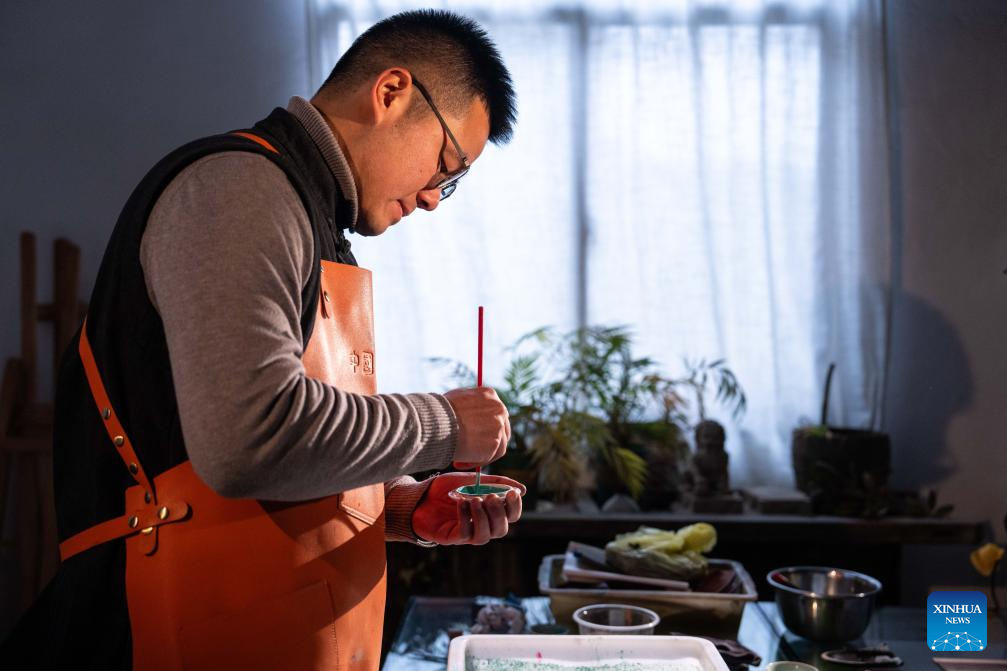
Hao Guanxiong prepares for making lacquer coated fan at his studio in Changsha, central China's Hunan Province, Feb. 28. 2024. Chu-style lacquer coating craft took shape during the Spring and Autumn Period (770 B.C.-476 B.C.) and the Warring States Period (475 B.C.-221 B.C.). Over the past thousands of years, this oriental craft has been mainly used on wood carving artworks and famous for its complicated making, distinguished styles, varied patterns and saturated colors. In 2011, the craft was listed as one of the national-level intangible cultural heritage. (Xinhua/Chen Sihan)
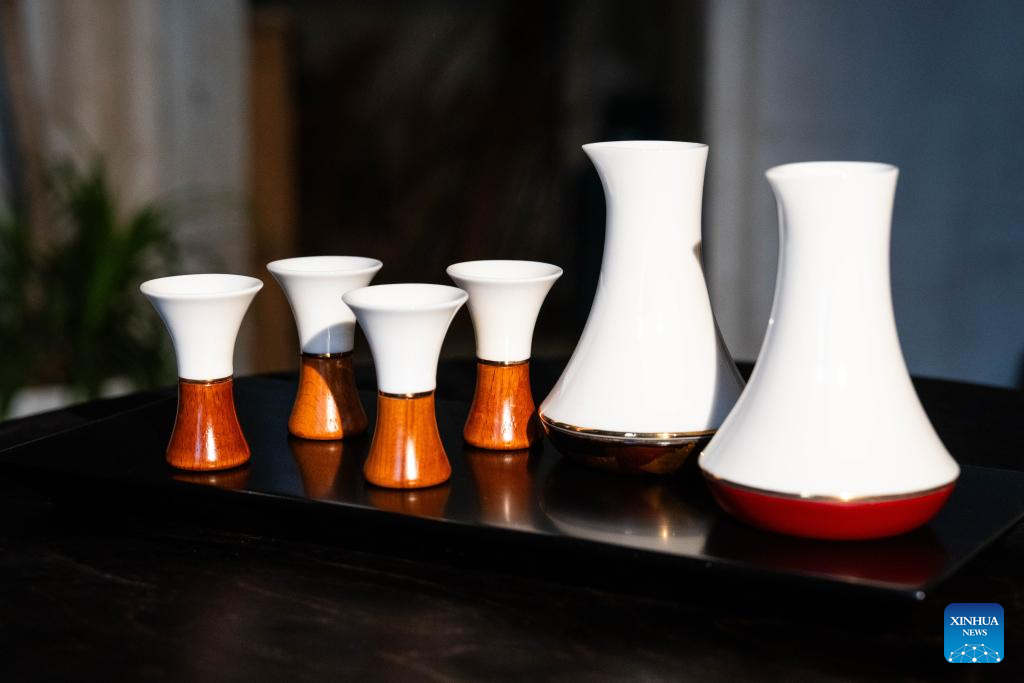
Lacquer coated drinking vessels are displayed at Hao Guanxiong's studio in Changsha, central China's Hunan Province, Feb. 28. 2024. Chu-style lacquer coating craft took shape during the Spring and Autumn Period (770 B.C.-476 B.C.) and the Warring States Period (475 B.C.-221 B.C.). Over the past thousands of years, this oriental craft has been mainly used on wood carving artworks and famous for its complicated making, distinguished styles, varied patterns and saturated colors. In 2011, the craft was listed as one of the national-level intangible cultural heritage. (Xinhua/Chen Sihan)